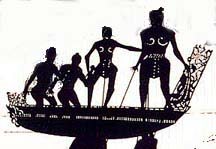Wayang Karetao by Joko Susilo
Jack Body of Victoria University, Wellington first conceived the idea of shadow puppet performance using Maori stories about four years ago. Karetao was first performed during the Aoraki festival in Timaru in 1997. The story performed in the festival was Summer Starlight Winter Moon by John Broughton, which involved hand puppets, shadow puppets, human shadows, Maori movement in front of the screen and projector slide.
Unlike Sandosa, (whose performers are professional puppeteers with great skill) the Karetao puppets are handled by non-puppeteers and are designed rather differently than Javanese shadow puppets. Javanese shadow puppets generally have three handles, although the Karetao shadow puppets have five handles. By holding one body handle the puppet figure walks and the non puppeteer does not need to concern him/herself with the other handles.
The Karetao figures are made from card-board and are not as pliable as the leather Javanese shadow puppets.The technique of Karetao performance is similar to that of Sandosa in that the screen is never empty of shadows.
I adapted the stories from Maori myths of a great eagle Pouakai that once terrorised Canterbury; a Kopuwai, a monster with the head of a dog and the body of a man; and Whakatu Kararahuarau, the story of a great lizard that devoured people from Rapuwai villages.
I had to get permission and advice from Maori in the South Island to present these stories and I worked with Maori people to be sure the stories would be acceptable. I put two pou-- image of Maori god -- beside the screen and I put lights in the eyes. Two people put their hands through the pou and did actions in time with a karakia -- a chant -- at the beginning of the performance.
The kayon
In Javanese puppetry, the kayon is used for anything. In Karetao, I used the kehua (a spirit) with a movable head. This kehua could be anything -- maybe a storm, maybe wind, maybe fire. This sacred Maori figure became the kayon in the Wayang Karetao.

Aoraki and his brothers in the waka (Maori canoe).